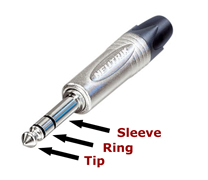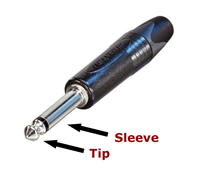TRS Cables – Balanced or Stereo?
Posted: 27 September 2010
Comments: 0 [Post]
Synopsis: A TRS cable can carry either a balanced audio signal or a stereo audio signal. It depends on what audio output you connect the cable to. People often ask, “Are the TRS cables balanced?” The answer is “They can be, if you connect the cable between a balanc

A TRS cable can carry either a balanced audio signal or a stereo audio signal. It depends on what audio output you connect the cable to. People often ask, "Are the TRS cables balanced?" The answer is "They can be, if you connect the cable between a balanced TRS output and balanced TRS input."
Another common misconception is that a TRS cable is the same as a guitar lead. They do feature the same ¼" sized 'jack' connectors, but there is a big difference.
A TRS cable has TRS (Tip, Ring, Sleeve) connectors on either end of a cable with two conductors, meaning TRS cable can carry two individual audio signals. Note that a TRS connector has two black insulation rings;
 |
One audio signal is transferred through the 'Tip' of the TRS connector, while the second signal is transferred through the 'Ring'. The 'Sleeve' area is used for the ground signal (not audio). A ¼" guitar lead or TS (Tip, Sleeve) connector features just one insulation ring;
|
 |
One insulation ring means a guitar lead connector can only carry one audio signal, through the 'Tip', plus the ground signal on the 'Sleeve'. Thus a TS guitar lead can only ever be 'mono and unbalanced'. The ability for a TRS cable to carry 2 lines of audio makes it capable of transferring both 'balanced' and 'stereo' audio. A balanced audio signal consists of 2 versions of the one signal (normal + inverted), so in essence balanced audio is 2 individual signals, it's just that these are combined by the input device to create one 'noiseless' signal. Audio mixers and processors will often have balanced TRS inputs and outputs.
|
A stereo audio signal consists of 2 individual signals (left + right). TRS stereo outputs and inputs will keep the left and right channels of audio separate from one another, ready for amplification in true stereo. A headphone output is the perfect example of a TRS stereo output.
It is worth remembering that a TRS cable can carry a balanced mono signal, or an unbalanced stereo signal. A TRS cable cannot carry a balanced stereo signal, as that would require the cable to have 4 conductors and the connector 5 contact points (or 4 black insulation rings).
A TRS connector can also be different sizes. The standard is ¼" or 6.35mm, the same size as a guitar lead jack. Though TRS connectors can also be 1/8" or 3.5mm, like that found on Ipod or MP3 headphones. Just remember TRS stands for 'Tip, Ring, Sleeve', and means 'connector with 2 black rings'.














